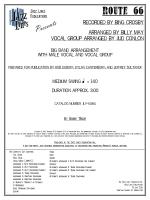ROUTE 66
Recorded by Bing Crosby with the Jud Conlon Rhythmaires Vocal Group
Music Arranged by Billy May, Vocal Group Arranged by Jud Conlon; Prepared for Publication by Rob DuBoff and Jeffrey Sultanof

Cat #: JLP-6084
$75.00This item usually ships within 1 business day.
Questions?
Please call +1-518-587-1102 or email us.
Edition: Jazz Big Band Arrangement with Vocal Soloist and Vocal Group [SAATT]
Description: Swing - Medium Difficult
Publisher: Jazz Lines Publications
In 1941 Bobby Troup and his wife Cynthia decided to head to California as he had designs on becoming a Hollywood songwriter. They set out from their home in Pennsylvania on U.S. Route 40 and eventually connected with U.S. Route 66. Somewhere along the way Troup decided it would be fun to write a song about their trip; however, the story goes that his initial idea was to write about their travels on Route 40. Troup's wife Cynthia suggested he instead focus on Route 66 and provided the now-famous line, "Get your kicks on Route 66." Troup included in the song many of the towns and cities they passed through. The timing of this song was perfect: America was being transformed into a car-centric society and travel by automobile was becoming king. This also coincided with the birth of the motel concept and, at the same time, the U.S. Transportation Department was launching the campaign to build highways around the United States. As people began to invest more time in leisure activities this composition became the theme song for their travel and undoubtedly also inspired a generation of people to head out and explore the United States. In short, this was the right song at the right time and became the soundtrack for America's newfound enthusiam for automobile travel.
Nat 'King' Cole, with his Trio, first recorded the song on March 15, 1946 in Los Angeles. Capitol Records released it as a single and it reached number three on Billboard magazine's Race Records chart and number eleven on its singles chart. Cole later re-recorded the tune for the album After Midnight (1956) and The Nat King Cole Story (1961). Bing Crosby and the Andrews Sisters recorded a version on May 11, 1946 which reached number 14 on the Billboard chart. Later in 1946, Bing Crosby began his residency on the Philco Radio Time show, an engagement that would last until 1949. As he began this radio show he needed a new library of arrangements, so he turned to someone that could craft swinging material in a hurry: Billy May.
This Billy May arrangement is a wonderful swinging take on Troup's hit song. The chart is primarily a back-and-forth between the male vocalist and a vocal group [SAATT]. It is interesting to note that in his score Billy May indicated the top line of the vocal group parts and Jud Conlon filled in the voicings in a separate vocal score for The Rhythmaires. In the radio broadcast The Charioteers are introduced as the vocal group, but it is clearly a group of studio singers (most likely The Rhythmaires) and not the famed gospel male vocal quartet.
Billy May's arrangement calls for a woodwind section consisting of three alto saxophones (two doubling on clarinet), one tenor saxophone, and two baritone saxophones. Included are alternate woodwind parts so that this arrangement is playable by two altos, two tenors, and two baritones. Or, two altos and three tenors (with or without the very short, 2 measure clarinet double).
This publication was preparing using the original Billy May pencil score and the set of parts used for the radio broadcast - this is not a transcription.
Male Vocal
Vocal Group [SAATT]
Woodwind 1: Alto Saxophone/Clarinet
Woodwind 2: Alto Saxophone
Woodwind 3: Alto Saxophone/Clarinet
Woodwind 4: Tenor Saxophone
Woodwind 5: Baritone Saxophone
Woodwind 6: Baritone Saxophone
4 Trumpets (Trumpet 4 Optional)
3 Trombones
Bass Trombone (Optional)
Guitar
Piano
Bass
Drums
Alternate Woodwind 1: Alto Saxophone (No Clarinet Double)
Alternate Woodwind 3: Tenor Saxophone/Clarinet
Alternate Woodwind 3: Tenor Saxophone (No Clarinet Double)
Alternate Woodwind 5: Tenor Saxophone
Trumpet 1: B5
Trombone 1: B4




